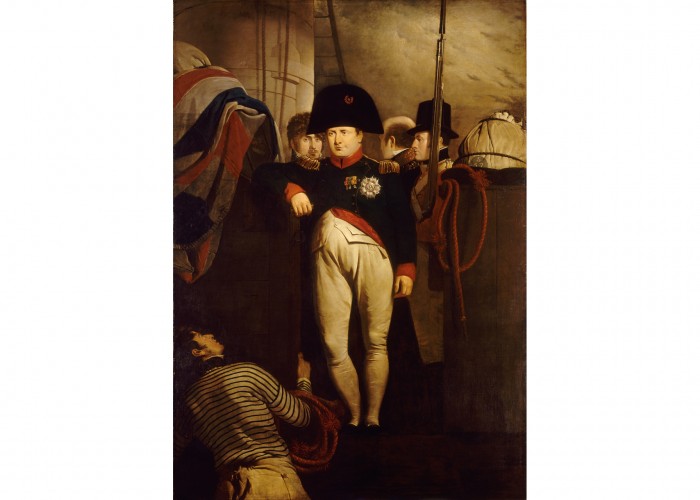Napoleon Bonaparte on Board the ‘Bellerophon’ in Plymouth Sound, Charles Lock
This painting by the British artist Charles Lock shows Napoleon Bonaparte shortly after the Battle of Waterloo, while he was a prisoner on the British ship HMS Bellerophon in the harbour of Plymouth. After the French defeat at Waterloo, Napoleon surrendered to the Royal Navy and was held captive while the victorious Allied powers decided what to do with him.
In the aftermath of Waterloo and his second and final abdication as Emperor, Napoleon lingered for a time in Paris before heading for the port of Rochefort from where he hoped to escape to the Americas. Instead, he found the port blockaded by the Royal Navy, rendering escape impossible. So it was that on 15 July 1815 the defeated Emperor surrendered himself to Captain Frederick Maitland of HMS Bellerophon. He would spend the remaining years of his life as a prisoner of the British.
In many ways, this particular warship was an apt choice to receive Napoleon’s final submission. A 74-gun ship-of-the-line, she had been launched in 1786 and had taken part in three of the most important naval battles of the era: the Glorious First of June, back in the days of the French Revolution; the Nile, which had nearly trapped the then General Bonaparte in Egypt; and Trafalgar, where Nelson’s victory had crushed French hopes of maritime domination. In the ten years since Trafalgar the ageing battleship, known to her crew as the “Billy Ruffian”, had been part of the naval blockade that had cut Napoleon’s empire off from outside trade and helped ensure its collapse.
Eventually, Napoleon would be sent into exile on the island of St Helena, remote in the South Atlantic. First, however, the Bellerophon brought him back to England, anchoring in Plymouth Sound where the ship was besieged by sightseers keen to catch a glimpse of their country’s long-standing foe and bogeyman.
This scene depicts Napoleon and some of his suite aboard the Bellerophon. The Emperor is wearing his habitual garb of an undress coat of the Chasseurs á Cheval of the Imperial Guard, and, even as a prisoner, is the central dominating figure of the image. The sailor in the foreground, and, indeed, we the viewers, are forced to look up to him. Were it not for a watchful Royal Marine sentry to the right of the scene, it would be hard to know that he was a prisoner at all.
Napoleon was subsequently transferred to another warship, HMS Northumberland, which carried him to St Helena along with a few followers. There, on 5 May 1821, the one-time conqueror of Europe died. Officially, the cause of his death was stomach cancer, and this remains the most likely explanation; nevertheless, the story still persists that Napoleon was poisoned, even though the scientific evidence for this is slim at best.
-
Education overview
Sources:
Cordingly, David, Billy Ruffian. London, Bloomsbury, 2004.
McLynn, Frank, Napoleon. London, Pimlico, 1998.
The Bellerophon surrounded by sightseers: http://collections.rmg.co.uk/mediaLib/287/media-287732/large.jpg
-
Curatorial info
- Originating Museum: National Maritime Museum
- Accession Number: BHC2876
- Production Date: 1815
- Creator: Charles Lock
- Material: Oil on canvas
- Creation Place: Eastlake
- Technique: Oil painting
- Size: 2591 x 1790 mm
-
Use this image
You can download and use the high resolution image for use in a non-profit environment such as a school or college, but please take note of the license type and rights holder information below
- Rights Holder: Copyright Royal Museums Greenwich.
- License Type: All Rights Reserved







